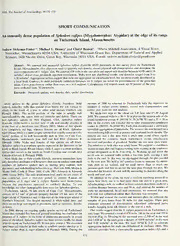
An unusually dense population of Sphodros rufipes (Mygalomorphae: Atypidae) at the edge of its range on Tuckernuck Island, Massachusetts PDF
Preview An unusually dense population of Sphodros rufipes (Mygalomorphae: Atypidae) at the edge of its range on Tuckernuck Island, Massachusetts
2011.TheJournalofArachnology39:171-173 SHORT COMMUNICATION An unusually dense population ofSphodws riifipes (Mygalomorphae: Atypidae) at the edge ofits range on Tuckernuck Island, Massachusetts AndrewMckenna-Foster'-^ MichaelL. Draney-and CherylBeaton': 'Maria MitchellAssociation,4 Vestal Street, Nantucket, Massachusetts02554 USA; ^UniversityofWisconsin-Green Bay, DepartmentofNatural andApplied Sciences, 2420 Nicolet Drive, Green Bay, Wisconsin 54311 USA. E-mail: [email protected] Abstract. We counted and measured Sphodrosrufipes(Latreille 1829) pursewebs in two survey plots on Tuckernuck Island,Massachusetts.Ourobjectivesweretoquantifywebdensity,recordphysicalwebcharacteristicsanddeterminethe maincomponentsof5.rufipes’diet.Wecounted479websinthetwoplotsandreportwebdensitiesbetween0.058and0.18 webs/m^,denserthanpreviouslyreportedpopulations.Webswerenotdistributedevenly,anddensitiesrangedfrom0to 0.38webs/m".Aggregationindicessuggestthatwebsareaggregatedonalandscapelevel,butaremoreevenlydistributedat alocallevel.ContrarytomostpreviouslypublishedliteratureonS. rufipes, wenotedthepredominanceofthegrass-like sedge,Carexpensylvanica, ratherthantrees,asawebsupport.Coleopteransandisopodsmadeup79percentoftheprey partscollectedfrom56pursewebs. Keywords: Pursewebspiders,webdensity,diet,spatialdistribution Most spiders in the genus Sphodros (family Atypidae) build summer of2008 we returned to Tuckernuck with the objectives to vertical, tube-like webs that extend from below the soil surface to estimate S. rufipes colony density, record web characteristics, and attach to the trunk ofa tree or other solid surface (Gertsch and collectpreypartsfordietanalysis. Platnick 1980). The aerial portion of the tube is usually well We made two trips tothe island on 5-8 Juneand 17-20August camouflaged bythespiderwith soil particlesand debris. Thereare 2008.Wecountedwebsina50X50mplotonthewesternsideofthe two Sphodros species in New England, USA. Sphodros rufipes island(southwestcorner41.304558°N,70.26798°W)anda37X50m (Latreille 1829)buildsavertical tubeofsilkand usuallyattachesit plotontheeasternside(smallerduetotimeconstraints)(southwest tothebaseofadeciduoustree(Hardy2003). Malesofthisspecies corner41.29922N,70.24516°W).Eachplotencompassedapreviously have completely red legs, whereas females are all black. Sphodros identifiedaggregationofpursewebs.Thewesternsitewaslocatedona niger(Hentz1842)isamorecrypticspeciesthatusuallyconstructsthe western-facinghillcoveredingrassesandscatteredheathshrubs.The ‘aerial’ portion ofits web horizontally and, at least on Cape Cod, eastern site was a Hat area with a pitch pine stand (Pinus rigida) Massachusetts, underneath pine duff and leaf litter (Edwards & surrounded by extensive black huckleberry clones (Gciyhissacia Edwards 1990). Males and females of this species are all black. baccata)andpatchesofgrassland.Neithersitewasnearopenwater. Sphodrosrufipesisasouthernspeciesreportedintheliteratureasfar Thesubstrateatbothsiteswassandyloam.Weassignedacoordinate northasBlockIsland,RhodeIsland,whileS.nigerisamorenorthern systemtoeachplotandbegancountingwebsstartingatthesouthwest speciesthatoccursasfarsouthasNorthCarolinaandextendsinto cornerdesignatedas(0m,0m)(Fig. 1).Walkingupanddownthe Canada(Gertsch&Platnick 1980). north axiswecounted webswithin a Im-wide path, startinga new Mostlikelyduetotheircrypticlifestyle,previousresearchershave pathtotheeast.Inthisway,wezig-zaggedthroughtheplotparallel onlydescribedattributesandbehaviorsthatcanbestudiedwithsmall totheeastaxis.Wehelda Im"quadratframetomeasurethemeter- numbers of Sphodros spiders such as mating, prey capture, web wide path as we walked, and we used survey Hags to mark our placement,andweb-buildingbehaviors(e.g.,McCook1888;Muma& previouspathandlineusupforthenextpassthroughtheplot.We Muma 1945;Coyle&Shear 1981;Coyle 1983;Edwards&Edwards recordedthelocationofeachwebbymeasuringitsdistancealongthe 1990;Hardy2003).Theonlypopulation-levelstudyweareawareof northandeastaxes. was conducted over a two-year period in eastern Kansas on Inadditiontotheplots, weusedarandomsearchingprotocolto populations of S. niger and S. rufipes. Results were inconclusive, assesshowlikelyoneistofind morethanonewebinagivenarea. because the populations appeared to suddenly decline. To our Afterlocatingaweb,wewalkedinthreerandomdirections,eachfora knowledge,nootherdemographicdataexistforSphodrosspecies. randomdistancebetweenzeroand50m,andcountedthenumberof Tuckernuck Island, 50 km south ofCape Cod, Massachusetts, webs weencountered. In all webencounters, weassumed that any consistsof3.3 km^ ofprivate property located 2.9 km west ofthe webthatwascylindricalratherthanfiattenedwasoccupied. largerislandofNantucketand14kmeastoftheevenlargerislandof Withinandaroundtheeasternandwesternplotswecollectedthe Martha’s Vineyard. The largest mammal is white-tailed deer, and remains ofprey items from 56 webs for diet analysis. These prey therearenolargescavengersorpredators,suchasraccoons,skunks, remnants consisted of disarticulated sclerotized arthropod parts, orfoxes. usuallyhangingfromsilkthreadsatthetopofaweb. In 2006, duringan ongoing spiderspecies survey ofTuckernuck OurresultssuggestthattheS.rufipespopulationonTuckernuckis Islandthatincludedfivehoursofgroundsearching,weconfirmedthe verylarge.Wecountedatotalof479webs,146inthewestand333in presenceofS. rufipesintheformofnumerouspursewebsingrassy theeast(Fig. 1).Dividingbythesurveyedarea(2,500m"inthewest areasoftheisland.Sphodrosrufipeshasbeenknownlocallyformany and 1,850m^intheeast)givesadensityof0.058webs/m^inthewest yearstooccuronTuckernuck(D.Brownpers.comm.).Weexcavated and 0.18 webs/m^ in the east. We used APACK 2.23 to calculate specimens(allfemale)intheirwebstoconfirmspeciesidentityasS. aggregationindicesforeachsite(Mladenoff&DeZonia2004).This rufipesrather than S. niger (Gertsch & Platnick 1980). During the softwareprovidesbothaclass-specificaggregation index(AI)anda 171 172 THEJOURNALOFARACHNOLOGY pers.comm.)studiedonewithadensityof0.01webs/m^inLouisiana. Morrow(1986)inKansasandTomChase(pers.comm.)onMartha’s Vineyard, Massachusetts,studiedpopulationsthatappearedtohave morethanonehundredwebsinunmeasuredareas.OnTuckernuck, thedensityattheeasternsite(0.18)ismorethanfourtimesPoteat’s (1889) population density and 14 times the density Hardy (2003) describes.OurrandomsearchprotocolshowedthatS.nifipesarenot usually found alone or in isolated groups. We came across 12 additionalwebsoutsidethestudyplots,locatedinsevengroups(each groupcontainedbetweenoneandthreewebswithinonem^)spread across theisland. We usedourrandomsearchingprotocolatthese sevensitesandlocatedanadditional 17webs.Welocatedadditional websatfiveofthesevengroups(71%).Oursuccessatfindingmore websafterlocatingoneweborasmallgroupofwebs,suggeststhatS. nifipes on Tuckernuck occur in groups ranging from small aggregationstolargecolonies. VegetationusedforwebattachmentisunusualonTuckernuck.At thewesternplot,83percentofthewebswereattachedtonon-woody objects(predominantlyPennsylvaniasedge,Ccirexpensylvanica),and 16percentwereattachedtoawoodyshrub.Theaverageaerialweb lengthwithstandarderrorwas 11 ± 0.36cm,butthedistancefrom thegroundtothetopofanyonewebvariedgreatly(1-15cm).Inthe eastern plot, 51% ofthewebs wereattached to non-woodyobjects (again,predominantly C.pensylvanica),and41%wereattachedtoa woodyshrub(predominantlyGayliissaciahaccata).Oneofthesewebs wasattachedtoapitchpine(Piunusrigida)(25cmdiameteratbreast EasternPlot height).Thisisunusual,forpinesarenotmentionedaswebsupports inanyotherstudy.Another8%wereattachedtootherobjectssuchas a dead leaf, a dead log, or dead pine needles. The webs were on average9.9±0.88cmlongandtheheightfromthegroundtothetop, again,variedgreatly(0.5-15cm). ThereisonlyonepreviousreportofS. nifipesusinggrassasaweb support(Muma&Muma1945),andmoststudiesdescribethespiders usingtrees. Hardy(2003) reported that S. rufipesin his studyarea used deciduous trees and avoided coniferous trees. Our findings stronglysupportaviewthat S. nijipeswill usewhateversupportis available,eventherareconifer. Deciduoustrees(mostlyoaks)exist on Tuckernuck and form acentrally located forest, but incursory surveyswedidnotfindanywebsattachedtothesetrees.Largeoaks werenotpresentinoursurveyplots.Spidersdidusethesmallwoody shrubGayliissaciahaccata.Coyle&Shear(1981)notedthat5.rufipes inFloridapreferredsmallertrees(< 10cm)tolargerones. Wefoundpreyremnantson50%ofwebs(n= 111).Coleopterans andisopodswerethemostabundantpreyitems,foundon42%and 38%ofthesampled webs, respectively(sampledwebsrefertowebs that contained prey parts). The most common coleopterans were Meters Scarabaeidae(43%ofcoleopteranspecimens)andElateridae(17%). We found several other orders represented on only a few webs, (wiutpFhpiiegnrurtaehnedIn.e—laorwSeepsarttigdarelaepidhmises,ttrerirebsuaptteictothnievoeslfay5)m..plneifdipweesstweerbnsa(nddotes)asptleortntepdlottso aSinhncedlaurHdyi(nm1ge9n8D1oi)pptlaoendrdaaM((11u.4m8%%)a.of&OwueMrbusd)ma,taaOp(ai1rl9ei4o5sn)ie,msilw(a3hr.o6t%oa)l,tshoAorscaeonleoleafcetCeo(d7y.lp1er%e)&,y partsfromS. rufipeswebs. A possible explanation for the high densities we observed on landscape aggregation index (AR) with values between zero Tuckernuckislowpredationrates.Wedidnotfindevidenceofany (disaggregated) and one (completely aggregated) (He et al. 2000). predation, and there are no mammal scavengers on the island. TheAll represents the level ofaggregation forbothquadrats that However,predationonS. rufipeswebshasbeenobservedonBlock contained websand thosethatdid not. At 1-m resolution, theweb Island,R.I.inlateMarch(E.Edwards,pers.comm.).Edwardsfound specificAlforthewesternsiteis0.265andtheAIlis0.938.Theweb webspulledupanddugoutoftheground,probablybyring-necked specificAlfortheeasternsiteis0.294andtheAIlis0.827,alsoat 1- pheasants.Toourknowledge,therearenopheasantsonTuckernuck. mresolution.Onalandscapelevel,thewebsarefairlyaggregated,but ACKNOWLEDGMENTS thewebspecificAIssuggestthatwebsarerelativelydispersed. Toourknowledge,theTuckernuck populationoccursincolonies This project was funded by a grant from the Nantucket thataredenserthanotherreportedpopulations.Forcomparison,we Biodiversity Initiative, and equipment and logistical support was compiled web numbers and, when available, the sampled area provided by the Nantucket Maria Mitchell Association. Wewould reported by other researchers. Poteat (1889) studied a population like to thank the Tuckernuck residents and the Tuckernuck Land thatcontained0.04webs/m^inNorthCarolina,whileHardy(2003, Trust(TLT)forallowingusaccesstoprivatepropertyandtheTLT MCKENNA-FOSTERETAL.—DENSEPOPULATIONOFSPHODROSRUFIPES 173 fieldstation.WeareindebtedtothelateR.L. EdwardsandtoE.H. Hardy, L.M. 2003.Trees usedfortubesupport bySphodrosrufipes Edwardsforpointing ustowardthiswork andcommentingon the (Latreille 1829) (Araneae, Atypidae) in northwestern Louisiana. manuscript. L.M. Hardy and J. Goyette also provided helpful JournalofArachnology31:437^40. comments that greatly improved this manuscript. R. Kennedy lent He, H.S., B.E. DeZonia & D.J. Mladenoff. 2000. An aggregation ushisboattotraveltoTuckernuck. index (AI) to quantify spatial patternsoflandscapes. Landscape Ecology 15:591-601. McCook, H.C. 1888. Nesting habits of the American purseweb LITERATURECITED spider. Proceedings of the Academy of Natural Sciences of Coy(lAer,anFe.aAe,.M1y9g8a3l.omAoerripahlaed)i.spJeorusralnalbyofmAyrgaachlnoomloorgpyh11s:p2id8e3r-l2i8n6g.s MlaPdheinloafdfe,lphDi.aJ.40&:20B3.-2D2e0Z.onia. 2004. APACK 2.23 User’s Guide. Coyle,F.A.&W.A.Shear. 1981.Observationsonthenaturalhistory Department ofForest Ecology and Management, University of eovfiSdpehnocderofosrahaboctointaancdtSspehxodprhoesrroumfoinpees.(AJroaunrenaael,oAftyApriadcahe)n,olwoigtyh MorWrisocwo,nsWi.n-1M9a86d.isAonr,anMgaedeixstoenn,siWoinsocfontshienp.ursewebspiderSphodros 9:317-326. rufipes in eastern Kansas (Araneae, Atypidae). Journal of Edwhaisrtdosr,yRo.fLa.N&ewE.EHn.glEadnwdarpdosp.ul1a9t9i0o.nOobfseSrpvhaotdiroonssnoignerth(eArnaanteuarea,l MuALmruaac,cashMn.(oAHlr.oagc&yhnKi1.d4Ea:.)1.1M9-Eu1nm2ta1o..mol1o94g5i.caBlioNloegwicsal56n:o1t2e2s-o12n6A.typushicolor GerAttsycphi,daWe.)J..Jo&urnN.all.ofPlAartnaicchkn.ol1o98g0y.1A8:2r9e-v3i4s.ion ofthe American PotMeiattc,heWl.lLS.cie1n8t8i9f.icASoctiuebtey-b6u:i1l3d4i-n1g47s.pider. Journal of the Elisha spiders of the family Atypidae (Araneae, Mygalomorphae). AmericanMuseumNovitatesNo.2704:1-39. Manuscriptreceived5March2010, revised25October2010.
